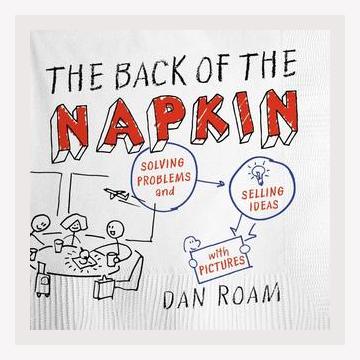Innovation and CreativityDesign Thinking
**
Introduction
Dan Roam’s 2008 book, “The Back of the Napkin: Solving Problems and Selling Ideas with Pictures,” falls under the category of Design Thinking and explores the power of visual thinking in problem-solving and idea communication. Roam argues that simple drawings and diagrams can be more effective than verbal explanations or written text. This summary outlines the book’s key points, actionable advice, and concrete examples.
1. The Power of Visual Thinking
Roam starts by illustrating the significance of visual thinking. According to him, our brain processes images 60,000 times faster than text. Visual tools can help in understanding complex problems, generating solutions, and communicating ideas effectively.
Action:
To leverage this, Roam suggests starting every problem-solving or idea-sharing session with a blank piece of paper and a pen. Instead of jumping into discussions or written explanations, sketch out the problem or key points.
Example:
Roam shares an anecdote where a simple sketch on a napkin helped a team at Boeing clarify a complex engineering problem that had been stalling their progress for weeks.
2. The Six Ways We See (SQVID)
Roam introduces the SQVID framework, which stands for:
- S: Simple vs. Elaborate
- Q: Quality vs. Quantity
- V: Vision vs. Execution
- I: Individual Attributes vs. Comparison
- D: Change vs. As-Is
This framework helps in understanding different perspectives and dimensions of a problem.
Action:
When faced with a problem, use the SQVID framework to draw six different images representing each dimension. This can help uncover insights and enhance understanding from multiple angles.
Example:
In a consulting meeting, Roam used SQVID to illustrate different business strategies and metrics, allowing the client to see potential outcomes and make a more informed decision.
3. The Visual Thinking Toolkit
Roam introduces a toolkit consisting of simple drawing techniques:
- Circle: To show groups or boundaries
- Line: To link or separate items
- Square: To indicate containers or categories
- Arrow: To show direction or movement
Action:
Maintain a basic visual toolkit at every brainstorming session. Use primitive shapes to represent concepts rapidly, without worrying about artistic skills.
Example:
Roam recounts a scenario where a team used circles and arrows to map out a supply chain, which helped them identify bottlenecks and streamline processes.
4. The Four-Step Visual Thinking Process
The book outlines a four-step process for visual thinking:
- Look: Collect and filter information.
- See: Understand the patterns and relationships.
- Imagine: Generate ideas based on what was seen.
- Show: Share these ideas through visuals.
Action:
For every project or challenge, follow these four steps rigorously. Begin by immersing yourself in data (Look), then map out patterns (See), brainstorm visually (Imagine), and finally, present the best ideas with diagrams (Show).
Example:
Roam describes a successful product development workshop where the team followed these steps. They identified user needs (Look), saw usage patterns (See), imagined innovative features (Imagine), and presented a prototype through sketches (Show).
5. The Roll of the Five W’s and H
Roam emphasizes using the traditional Five W’s (Who, What, Where, When, Why) and How in visual thinking:
- Who and What: Characters and actions
- Where and When: Context and sequence
- Why and How: Motivation and process
Action:
Draw a diagram for each ‘W’ and ‘H’. This ensures that all aspects of the problem or idea are considered, providing a holistic view.
Example:
In strategic planning sessions, using a ‘Who-What-Where-When-Why-How’ grid helped teams visualize market entry strategies comprehensively.
6. The Visual Decoder
Roam introduces the Visual Decoder matrix, which classifies visuals into six types:
- Flowcharts: Processes and flows
- Maps: Locations and layouts
- Charts: Quantities and measures
- Timelines: Sequences and milestones
- Diagrams: Conceptual links
- Graphs: Statistical data
Action:
Select the most suitable type of visual from the matrix depending on the nature of information you need to present. This increases clarity and relevance.
Example:
Roam illustrates using a flowchart to depict customer journey stages, helping a retail business optimize each interaction point.
7. Challenges in Visual Thinking
Roam acknowledges common challenges such as fear of drawing, overcomplication, and skepticism about visual thinking’s efficacy. He provides solutions to overcome these.
Action:
Practice by doodling simple images regularly. Start incorporating visuals in small, informal settings before scaling up their use.
Example:
Roam narrates how a team hesitant about drawing began with simple doodles during a casual meeting and gradually became proficient, incorporating sketches into formal presentations.
8. Applying Visual Thinking to Real-World Problems
The book includes case studies where visual thinking was applied successfully:
- A marketing team visualized customer segmentation, boosting campaign effectiveness.
- An NGO mapped resource allocation, improving project outcomes.
Action:
Identify current challenges in your organization and plan a visual thinking session. Use case studies from the book for inspiration.
Example:
A company struggling with employee engagement used mind maps to visualize feedback and brainstorm solutions, leading to a new, successful engagement strategy.
Conclusion
In “The Back of the Napkin,” Dan Roam presents a compelling case for using simple drawings to solve complex problems and sell ideas effectively. His methods are underpinned by the power of visuals in enhancing cognition and communication. By using frameworks such as SQVID, the Four-Step Process, the Visual Toolkit, and the Five W’s and H, readers can transform their approach to problem-solving and idea presentation.
Final Action:
Begin integrating visual thinking into your daily workflow. Start each day with a visual brainstorm session, and incorporate visuals in your meetings and reports. Over time, you’ll see improvements in clarity, engagement, and problem-solving effectiveness.
Example:
Roam concludes with a personal anecdote: a start-up that adopted visual thinking saved time and resources in product development and successfully raised venture capital by communicating their vision effectively through sketches.
By utilizing Roam’s principles and practical advice, anyone can harness the power of pictures to simplify complex issues and communicate ideas more effectively.
